![]()
![]()
![]()
Use LEFT and RIGHT arrow keys to navigate between flashcards;
Use UP and DOWN arrow keys to flip the card;
H to show hint;
A reads text to speech;
18 Cards in this Set
- Front
- Back

|
classic example of a lichenoid dermatitis; hyperkeratosis and acanthosis; prominent granular cell layer, sawtoothing of rete pegs, band like chronic inflammatory infiltrate (T cells and macrophages) that destroys the dermoepidermal junction; Civatte bodies (apoptotic basal cells, PAS+); artifactual cleft formation between epidermis and papillary dermis; occasional subepidermal bullae; no atypia
Lichen planus |
|

|
Lichenoid Drug Eruption
• Due to a number of drugs • May be enhanced in photo-exposed areas • Usually resolves after withdrawal of drug • Histology – Superficial and deep infiltrate, often with eos – DEJ obscured; Civatte bodies – Pigment incontinence |
|
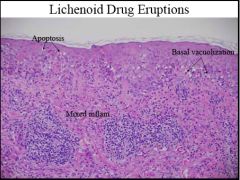
|
Lichenoid Drug Eruption
• Due to a number of drugs • May be enhanced in photo-exposed areas • Usually resolves after withdrawal of drug • Histology – Superficial and deep infiltrate, often with eos – DEJ obscured; Civatte bodies – Pigment incontinence |
|
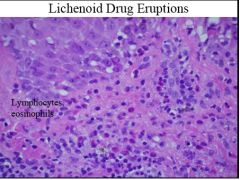
|
Lichenoid Drug Eruption
• Due to a number of drugs • May be enhanced in photo-exposed areas • Usually resolves after withdrawal of drug • Histology – Superficial and deep infiltrate, often with eos – DEJ obscured; Civatte bodies – Pigment incontinence |
|
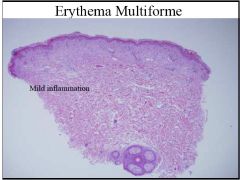
|
Erythema Multiforme
• Flat-topped purpuric macules or targetoid lesions • Often limited to trunk; may be diffuse – Related to HSV or other infections • Stevens-Johnson Syndrome – Oral/mucosal involvement; systemic symptoms – Related to drug intake • Histology – Superficial to mid dermal infiltrate, maybe scant – Basal vacuolization, Civatte bodies – Subepidermal vesiculation |
|
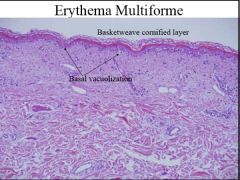
|
Erythema Multiforme
• Flat-topped purpuric macules or targetoid lesions • Often limited to trunk; may be diffuse – Related to HSV or other infections • Stevens-Johnson Syndrome – Oral/mucosal involvement; systemic symptoms – Related to drug intake • Histology – Superficial to mid dermal infiltrate, maybe scant – Basal vacuolization, Civatte bodies – Subepidermal vesiculation |
|

|
Erythema Multiforme
• Flat-topped purpuric macules or targetoid lesions • Often limited to trunk; may be diffuse – Related to HSV or other infections • Stevens-Johnson Syndrome – Oral/mucosal involvement; systemic symptoms – Related to drug intake • Histology – Superficial to mid dermal infiltrate, maybe scant – Basal vacuolization, Civatte bodies – Subepidermal vesiculation |
|
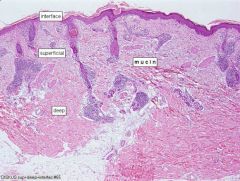
|
Systemic lupus erythematosus (SLE);fibrinoid necrosis at dermoepidermal junction with liquefactive degeneration and atrophy of epidermis; more mucin deposition in reticular dermis than discoid lupus
Positive stains: IgG, IgM, C5b-C9 (by direct immunofluorescence) in clinically involved skin as irregular band at dermoepidermal junction; IgG and IgM only in 50% in normal skin |
|
|
The histologic picture of spongiosis can be found in all of the following situations EXCEPT:
a. Contact dermatitis due to poison ivy b. Skin eruption from thiazide diuretics c. Erythema nodosum d. Pemphigus vulgaris e. HIV patients with seborrheic dermatitis |
c. Spongiosis
is an intracellular edema between keratinocytes in the epidermis. The edema may progress to spongiotic intraepidermal vesicles. Spongiosis is the hallmark of eczema but can be seen in other specific types of dermatitis. Erythema nodosum is characterized by a panniculitis-like picture with minimal epidermal involvement. |
|
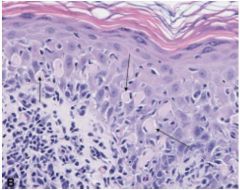
A biopsy of a solitary nonitchy papule on the skin reveals the following picture. The cellular bodies indicated by the arrows are formed from:
a. Disintegrated collagen b. PAS-positive cytoplasmic inclusions c. Colloidal iron d. Infiltrating IgM-positive histiocytes e. Apoptotic koilocytes |
b. Colloid bodies
are PAS-positive eosinophilic bodies found in the papillary dermis and lower epidermis in patients with lichen planus, drug eruptions, or lichenoid infiltrate. They consist of filaments and organelle remnants of apoptotic basal cells and appear as PAS-positive cytoplasmic inclusions. In lichen planus, they stain for IgM by direct immunofluorescence but they are not related to histiocytes. |
|
|
A biopsy of a solitary nonitchy papule on the skin reveals the following picture. The cellular bodies indicated by the arrows are formed from:
a. Disintegrated collagen b. PAS-positive cytoplasmic inclusions c. Colloidal iron d. Infiltrating IgM-positive histiocytes e. Apoptotic koilocytes |
b. Colloid bodies
are PAS-positive eosinophilic bodies found in the papillary dermis and lower epidermis in patients with lichen planus, drug eruptions, or lichenoid infiltrate. They consist of filaments and organelle remnants of apoptotic basal cells and appear as PAS-positive cytoplasmic inclusions. In lichen planus, they stain for IgM by direct immunofluorescence but they are not related to histiocytes. |
|

A 19-year-old HIV-positive man with a history of pneumocystis pneumonia developed erythematous, edematous macules symmetrically involving the skin of the arms, trunk, and legs, including the palms and soles. The diagnosis from this skin biopsy is:
a. Psoriasis b. Seborrheic keratosis c. Arthropod bite reaction d. Erythema multiforme e. Urticaria |
d.The image shows
interface dermatitis, which can occur in erythema multiforme, toxic epidermal necrolysis, dermatomyositis, SLE, and cytoxic drug eruption. Erythema multiforme and toxic epidermal necrolysis display marked keratinocyte necrosis. Blisters may develop in both disorders. The most frequent etiology of erythema multiforme is infection. However, drugs, particularly sulfonamides, can result in more severe form, termed Stevens-Johnson syndrome. |
|

A 19-year-old African American woman with proteinuria and arthritis involving the knee and ankle developed a skin rash on the cheeks. Her serum was positive for anti-dsDNA antibodies. The patient's skin biopsy is shown. The diagnosis can be confirmed with any of the following tests EXCEPT:
a. Acid-fast stain b. PAS stain c. Colloidal iron stain d. IgG and C3 immunofluorescence in biopsy from clinically normal skin e. IgG and C3 immunofluorescence in biopsy from clinically involved skin |
a. Systemic lupus erythematosus
is characterized by hyperkeratosis, follicular plugging, colloidal ironpositive dermal mucin, dermal lymphocytic infiltrate, and granular deposits of IgG and C3 along the epidermal basement membrane in lesional skin as well as normal skin. PAS stain will demonstrate thickened basement membrane. |
|
|
Lymphocytic cell infiltrate in the reticular dermis can be reliably diagnosed as mycosis fungoides if the cells are:
a. CD45+, CD30+, CD15+ b. CD3+, CD4+, CD8+ c. CD3+, CD4+, CD8+ d. CD20+, CD45+, CD10+ e. CD3+, CD8+, CD56+ |
b. Mycosis fungoides
may be considered a form of T-cell lymphoma of the T-helper phenotype. Cells express CD3 and CD4 and are negative for CD30 and CD7. The disease has a long course and appear as patches or plaques on the trunk that progress to infiltrative plaques. On histology, small cells with cerebriform or irregular nuclei infiltrate the dermis and epidermis. |
|

The diagnosis is most likely:
a. Staphylococcal scalded skin (SSS) syndrome b. Toxic epidermal necrolysis (TEN) c. Pemphigus vulgaris d. Systemic lupus erythematosus e. Pityriasis lichenoides et varioliformis acuta |
b.The image shows epidermal necrosis and bulla, which can occur in both SSS syndrome and TEN. In TEN, subepidermal bullae are formed. In SSS syndrome, the plane of cleavage is at or above the granular area.
Toxic epidermal necrolysis causes extensive sloughing of skin and may be life threatening. It is usually due to sulfonamides, phenytoin, and other drugs. |
|
|
Which of the following is NOT associated with human papillomavirus (HPV) viral infection?
a. Epidermodysplasia verruciformis b. Condyloma acuminatum P.59 c. Actinic keratosis d. Bowen disease e. Warty dyskeratoma |
e.Despite histologic similarities to viral warts, warty dyskeratoma is not a manifestation of
human papilloma virus infection. All of the other lesions are related to HPV infection. More commonly, verruca vulgaris occurs on the acral skin of the hands and feet as manifestation of HPV type 2 infection. |
|
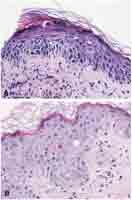
A 17-year-old girl developed macular erythematous skin eruptions in the face, neck, and upper chest. Two weeks earlier, she received bone marrow transplantation after finishing a course of ablation chemotherapy. Two skin biopsies of different sites are represented in the picture. The diagnosis is:
a. Pityriasis lichenoides et varioliformis acuta b. Viral infection c. Drug-associated linear IgA dermatosis d. Radiation dermatitis e. Acute graft-versus-host disease |
e. Acute graft-versus-host
disease in the skin is characterized by spongiosis of the epidermis, vacuolization, and necrosis in the basal layer of the skin and subepidermal mononuclear cell infiltrate. Necrotic keratinocytes can also be seen in fixed drug eruption, pityriasis lichenoides, connective tissue disease, radiation dermatitis, and some viral infections. Thus, an appropriate clinical history in combination with histologic findings is needed for a proper diagnosis. |
|

A 45-year-old white HIV-positive woman developed a generalized skin rash characterized by erythematous scaly papules and plaques with sharp borders. The diagnosis from this skin biopsy is:
a. Stevens-Johnson syndrome b. Pemphigoid c. Tinea corporis d. Psoriasis e. Acanthosis nigricans |
d. Psoriasis
is a common inflammatory disorder that is characterized by scaly pink to red papules and plaques. It commonly involves the scalp, sacral region, and extensor surfaces of the extremities. It can extend to involve the entire skin. Histologically it is characterized by hyperkeratosis, parakeratosis, acanthosis, elongation of the rete ridges, and epidermal microabscesses (Monroe abscesses). |

